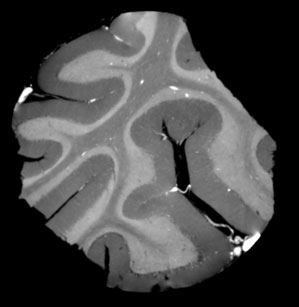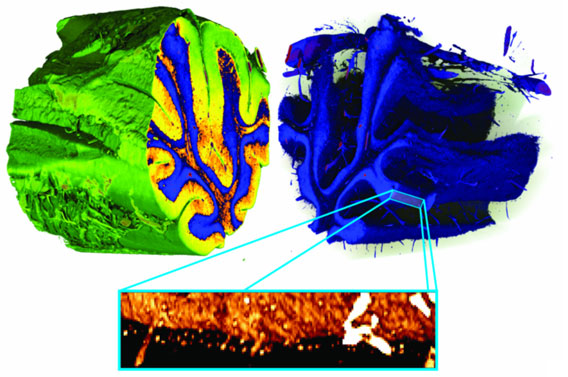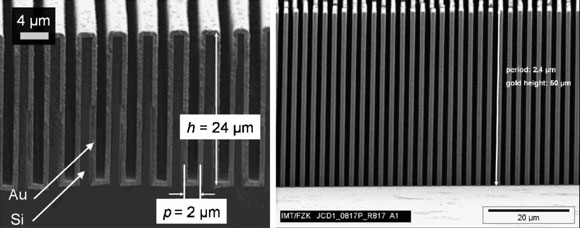- Home
- News
- Spotlight on Science
- New X-ray insight...
New X-ray insight into the human brain
05-01-2011
Three-dimensional images of the human cerebellum in unprecedented detail can be obtained using a new X-ray imaging technique, as scientists from Switzerland, Germany and France have now demonstrated. Using X-ray grating interferometry, they could even visualise individual cells without the use of a contrast agent.
Share
Modern medicine relies heavily on imaging techniques, both for clinical applications such as diagnostics and treatment planning and for fundamental research. However, present-day methods have their limitations. Visible-light microscopy can yield functional information in two and three dimensions, but has limited penetration depth and depth resolution. This is not a problem for X-ray radiography and tomography, which yield excellent two- and three-dimensional images of calcified tissue such as bone and teeth. For soft tissues, however, standard absorption X-ray images suffer from poor contrast. Magnetic resonance imaging solves this problem, but has insufficient spatial resolution to visualise individual cells.
Scientists from the University of Basel (Switzerland), Synchrotron Soleil (France) and the ESRF, together with groups from the Technische Universität München, HASYLAB, the Karlsruhe Institute of Technology (Germany) and the Paul Scherrer Institut (Switzerland), have now succeeded in recording three-dimensional X-ray images of the human brain in which the different types of soft tissue can easily be distinguished, and that even allow the visualisation of individual cells.
The images shown in Figures 1 and 2 were obtained using X-ray grating interferometry, a new, ultra-sensitive imaging method with exceptionally high contrast and good spatial resolution. This method was first developed at the Paul Scherrer Institut and later, by collaboration, implemented at the ESRF at beamlines ID19 and BM05 [1,2]. The images show the cerebellum, a part of the brain that has a decisive role in the coordination of movement and is also involved in other functions. While the experiment was performed in vitro on an extracted brain fixed in formalin, it is important to note that no contrast agent was used.
 |
|
Figure 2. A single tomographic slice from the phase-contrast tomography dataset. |
X-ray grating interferometry is an X-ray phase-contrast imaging method. Contrast is generated by the refraction of the X-ray beam while passing through matter, rather than by the absorption of the X-rays as in conventional radiography. The development of grating interferometry for X-rays was made possible by high-level European microstructure technology. This imaging method uses grid structures with high aspect ratio and a micrometre-sized pitch that modulates the phase and/or the amplitude profile of the X-ray wavefront. These gratings (Figure 3) can only be made by highly-advanced technological processes developed in dedicated research programmes at the Laboratory for Micro- and Nanotechnology of the Paul Scherrer Institut and at the Institute for Microstructure Technology of the Karlsruhe Institute of Technology.
With its high sensitivity, X-ray grating interferometry has great potential as an imaging method in fundamental biomedical research. At lesser spatial resolution than in this synchrotron-based study of the brain, it may also be applicable in clinical imaging, and provide better images at lower dose, for example in mammography. This is because, unlike some other X-ray phase-contrast methods, grating interferometry can be adapted for use on conventional X-ray sources such as the ones used in hospital equipment [3].
References
[1] T. Weitkamp, A. Diaz, C. David, F. Pfeiffer, M. Stampanoni, P. Cloetens, and E. Ziegler, Optics Express 13, 6296–6304 (2005).
[2] T. Weitkamp, I. Zanette, C. David, J. Baruchel, P. Bernard, M. Bech, H. Deyhle, T. Donath, J. Kenntner, S. Lang, J. Mohr, B. Müller, F. Pfeiffer, E. Reznikova, S. Rutishauser, G. Schulz, A. Tapfer, and J.-P. Valade, Proc. SPIE 7804, 780406 (2010).
[3] F. Pfeiffer, T. Weitkamp, O. Bunk, and C. David, Nat. Phys. 2, 258–261 (2006).
Principal publication and authors
G. Schulz (a), T. Weitkamp (b,c), I. Zanette (b), F. Pfeiffer (d), F. Beckmann (e), C. David (f), S. Rutishauser (f), E. Reznikova (g), and B. Müller (a), High-resolution tomographic imaging of a human cerebellum: comparison of absorption and grating-based phase contrast, J. Roy. Soc. Interf. 7, 1665–1676 (2010).
(a) Biomaterials Science Center, University of Basel, Basel (Switzerland)
(b) European Synchrotron Radiation Facility, Grenoble (France)
(c) Synchrotron Soleil, Gif-sur-Yvette (France)
(d) Department of Physics, Technische Universität München, Garching (Germany)
(e) Institute for Materials Research, GKSS Research Centre, Geesthacht (Germany)
(f) Laboratory for Micro- and Nanotechnology, Paul Scherrer Institut, Villigen (Switzerland)
(g) Institute for Microstructure Technology, Karlsruhe Institute for Technology, Karlsruhe (Germany)





